冀教版八年级上册Unit 6 Go With Transportation ! Lesson 32 Trains Go Faster !课件(共33张PPT)
文档属性
| 名称 | 冀教版八年级上册Unit 6 Go With Transportation ! Lesson 32 Trains Go Faster !课件(共33张PPT) | 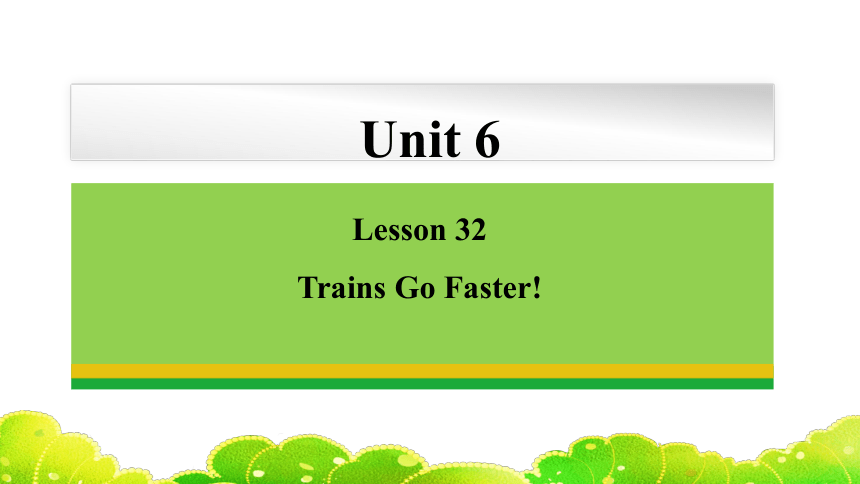 | |
| 格式 | pptx | ||
| 文件大小 | 9.8MB | ||
| 资源类型 | 教案 | ||
| 版本资源 | 冀教版 | ||
| 科目 | 英语 | ||
| 更新时间 | 2024-03-03 23:25:08 | ||
图片预览

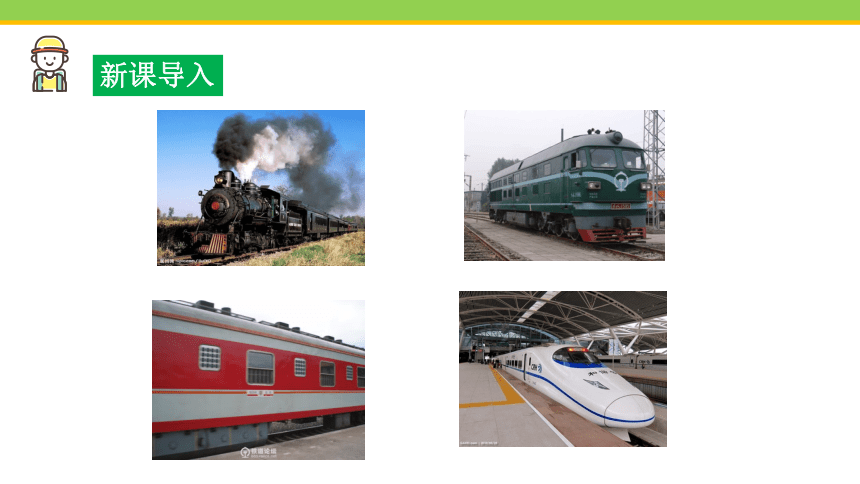
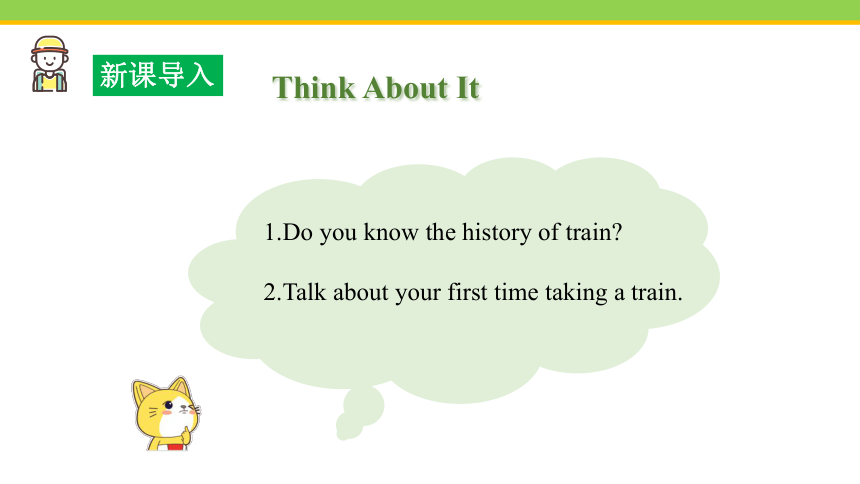
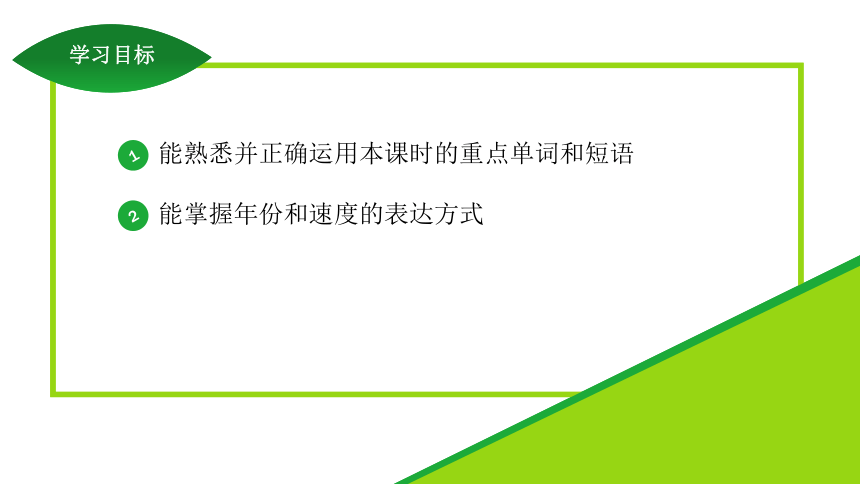

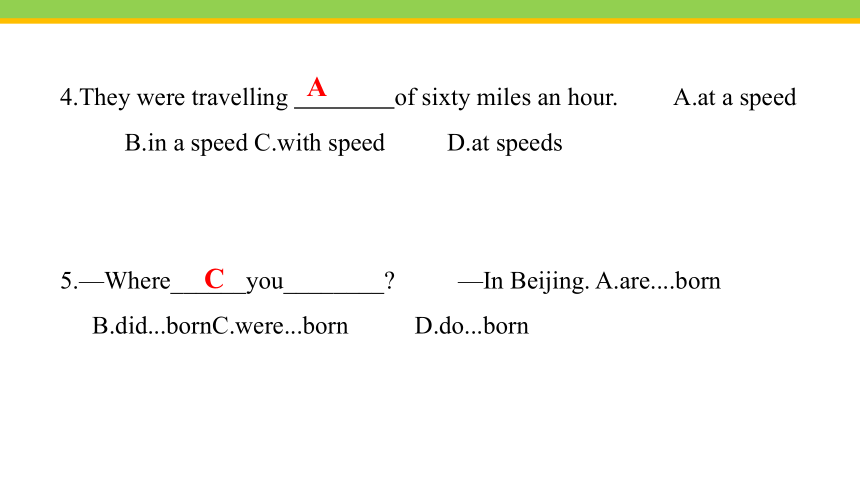
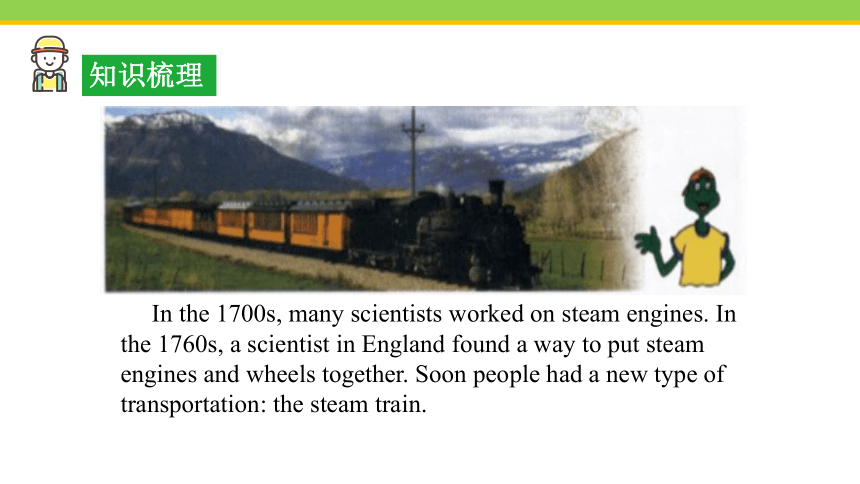
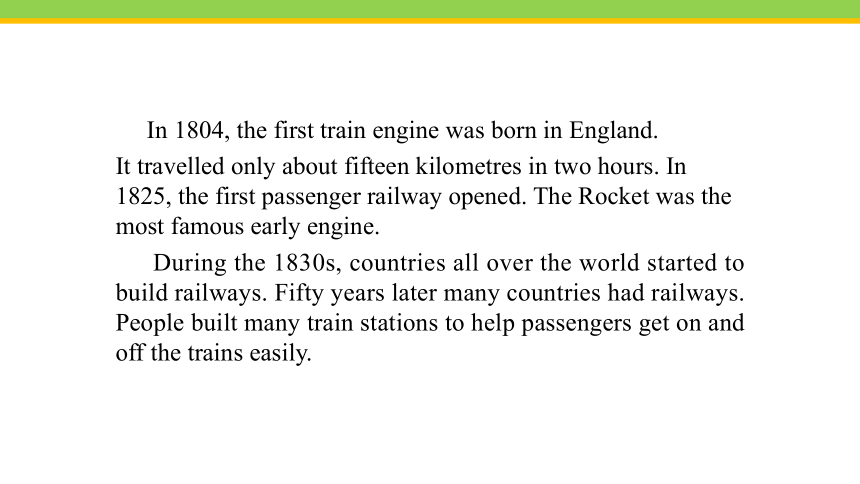
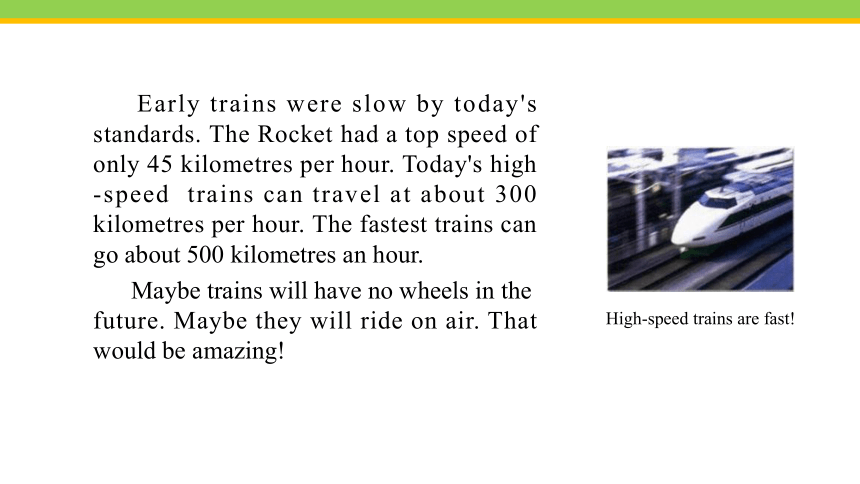
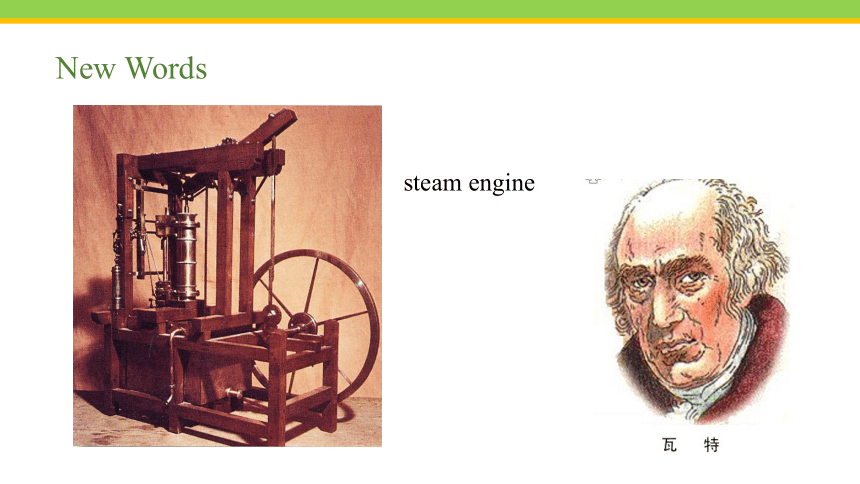
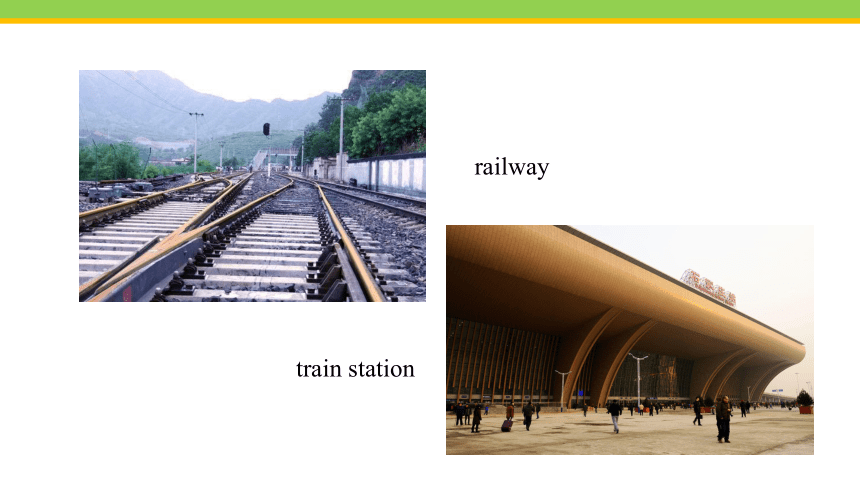
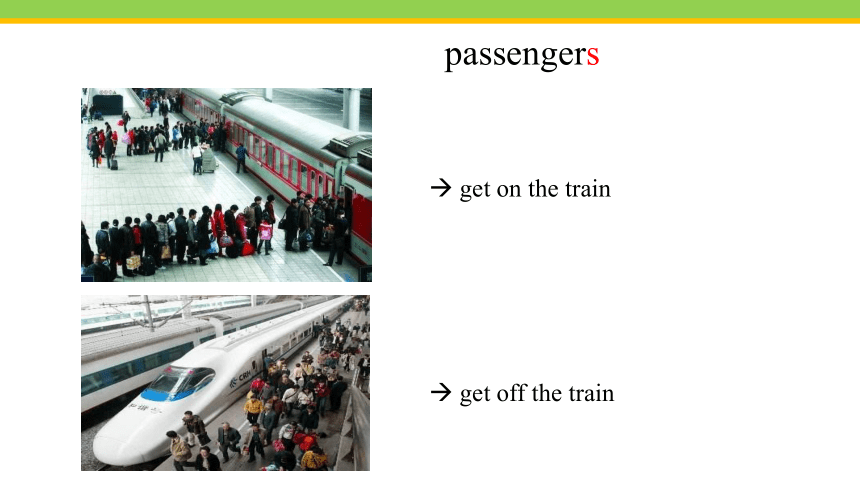
文档简介
(共33张PPT)
Unit 6
Lesson 32
Trains Go Faster!
新课导入
新课导入
1.Do you know the history of train
2.Talk about your first time taking a train.
Think About It
2
1
能熟悉并正确运用本课时的重点单词和短语
能掌握年份和速度的表达方式
预习检测
1.The bus is coming. Be careful when you the bus. A.get on B.get off C.get up D.get to
2.You will enjoy yourselves the summer holiday. A.during B.for C.with D.at
3.Thousands of young people went to the countryside to work with the farmers . A.in the 1970 B.in 1970s C.in the 1970s’ D.in the 1970s
A
A
D
4.They were travelling of sixty miles an hour. A.at a speed B.in a speed C.with speed D.at speeds
5.—Where______you________ —In Beijing. A.are....born B.did...bornC.were...born D.do...born
A
C
知识梳理
In the 1700s, many scientists worked on steam engines. In the 1760s, a scientist in England found a way to put steam engines and wheels together. Soon people had a new type of transportation: the steam train.
In 1804, the first train engine was born in England.
It travelled only about fifteen kilometres in two hours. In 1825, the first passenger railway opened. The Rocket was the most famous early engine.
During the 1830s, countries all over the world started to build railways. Fifty years later many countries had railways. People built many train stations to help passengers get on and off the trains easily.
Early trains were slow by today's standards. The Rocket had a top speed of only 45 kilometres per hour. Today's high speed trains can travel at about 300 kilometres per hour. The fastest trains can go about 500 kilometres an hour.
Maybe trains will have no wheels in the future. Maybe they will ride on air. That would be amazing!
High-speed trains are fast!
New Words
steam engine
railway
train station
passengers
get on the train
get off the train
重点探究
谈论火车发展史
Read and Answer
Time What happened
in the 1700s
in the 1760s
in 1804
in 1825
during the 1830s
50 years later(in the 1880s)
work on the steam engines
put steam engines and wheels together
the first passenger railway opened
build railways
many countries had railways.
train stations
the first train engine was born
How fast do trains go
Kinds of trains Speed
Early trains 15 kilometers in two hours
The fastest trains 500 kilometers per hour
Today's high speed trains about 300 kilometers per hour
The future trains have no wheels, ride on air
Come to “Let’s Do it !”
Read the lesson and answer the questions.
1.Where was the first train engine built
2.When did the first passenger railway open
In England.
In 1825.
3.How fast do today's trains go
4.What might future trains be like
Today's trains can go at about 300 kilometres per hour. The fastest trains can go about 500 kilometres an hour.
Maybe they will have no wheels and ride on air.
Listen to the dialogues and tick the correct information.
1.□in 1804 □in 1825 □in 1830
2.□30 kilometres an hour
□45 kilometres an hour
□54 kilometres an hour
3.□seven □seventeen □seventy
4.□50 kilometres an hour □500 metres an hour
□500 kilometres an hour
√
√
√
√
Language notes
1.In the 1700s:
many scientists worked on steam engines.
work on
从事于……,致力于…….
He is working on a new novel.
2.in the 1760s:
A scientist in England found a way to put steam engines and wheels together.
1)put…together, put…and…together
组成整体,拼在一起
He is trying to put a team together.
Put red and yellow together, you can get orange.
2)in the 1760s 意为“在18世纪60年代”。
in the 1760s = in the 1760's,
“in the + 年代的复数或所有格”意为 “在……世纪……年代”。如:
He was born in the 1930s.
他出生在20世纪30年代。
3.In 1804,the first train engine was born in England.
be born 出生, 诞生
(be 通常用was 或were)
I was born in Tangshan.
---When were you born
---I was born on July 5 in 1982.
4.In 1825,
the first passenger railway opened.
The Rocket had a top speed of only 45 kilometres per hour.
a top speed = a full speed 全速,最高速度
The train has a speed of 300 kilometres per hour.
=The train travels at a speed of 300 kilometres per hour.
per day每天 per hour 每小时
per kilometre每千米
per 每……(多指数量,价格, 时间)
have a speed of…= …at a speed of …
以...的速度
Come to “Let’s Do it !”
Complete the dialogue with the correct forms of the words in the box.
railway station speed passenger
Tom: Hello John. How are you doing
John: Hi Tom. I'm doing well. Have you been to our new ________ ________?
Tom: Not yet. How about you
John: I went there last month. It's bright and beautiful. It's easy for ___________ to get on and off the train. It was exciting. The train went really fast. It can reach a top ________ of 500 kilometres an hour.
Tom: That's really fast! I hope to ride it soon.
railway
station
passengers
speed
Practice
Try to retell the train history
In the 1700s, …steam engines… In the 1760, … steam engines and wheels…
In 1804, the first train engine … In 1825, the first passenger railway …
During the 1830s, …build railways.
Early trains …slow… The Rocket …a top speed… Today’s high-speed trains… The fastest trains …
Maybe trains …in the future…
You could retell it like this:
Come to “Let’s Do it !”
Read the passage and answer the questions.
Over two thousand years ago, Chinese people invented kites. Kites can fly like birds, but they can't take people up into the sky. Hundreds of years later, the Wright brothers made the first successful experiment. A machine carrying a man rose into the sky using its own energy. It was the first plane. Inventors went on to improve planes. Two engineers, Frank Whittle of the U.K. and Hans Von Ohain of Germany, developed the jet plane during the late 1930s.
1. Who invented kites
2. Can kites take people up into the sky
3. Where was Frank Whittle from?
Chinese people.
No, they can't.
The U.K.
Pair Work
Make a dialogue about Let's do it 4.
Hi!John.Do you know when did Chinese people invite kites
Over two thousand years ago.
活动小结
通过以上活动可知,火车的发展历程分为几个阶段:_________________________________________
———————————————————————————————————————————————————————————————————————————————————————————
In the 1760s,scientists invented the steam engine.
In 1804,the first train engine was born in England.
In1825,the first passenger railway opened.
Today's high-speed trains travel 500km/hour
Trains will have no wheels and ride on air.
当堂检测
根据汉语提示及首字母完成句子
1. The car has four ______ (车轮).
2. He often drives at a top s______ on his way home.
3. They have rented(租赁) this house for 2,000 yuan
p______ year.
4. This bus is crowded with _________ (乘客) on such a
snowy morning.
5. The ______ (发动机) can't start. There is
something wrong with it.
engine
wheels
peed
er
passengers
当堂检测
用所给词的适当形式填空
1. He was one of the greatest ________ (invent)
in the world.
2. Do you know when Henry Ford's factory
_______ (open)
3. The movie theatre ________ (build) last year.
4. It isn't easy for the little girl _______ (carry) the
heavy box.
5. What ______ you ______ (do) at this time
yesterday
were doing
inventors
opened
was built
to carry
当堂检测
翻译句子,每空一词
1. 这座房子是石头建成的。
The house ______ ______ ______ stone.
2. 这些发明都是20世纪80年代发明的。
These inventions were all produced
______ ______ ______.
3. 你听说玛丽昨天晚上发生什么事了吗?
Did you hear ______ _________ ______ Mary last
night
what happened to
is made of
in the 1980s
Unit 6
Lesson 32
课堂总结
language points:
work on从事于...致力于..
put..together..组成整体,拼在一起
in the+年代的复数或所有格 在..世纪...年代
be born 出生,诞生
have a speed of或at the speed of 以...速度
get on/off上/下车
谈论火车的发展史
重点单词:
wheel,born,passenger,
railway,most,station,
standard,speed
Unit 6
Lesson 32
Trains Go Faster!
新课导入
新课导入
1.Do you know the history of train
2.Talk about your first time taking a train.
Think About It
2
1
能熟悉并正确运用本课时的重点单词和短语
能掌握年份和速度的表达方式
预习检测
1.The bus is coming. Be careful when you the bus. A.get on B.get off C.get up D.get to
2.You will enjoy yourselves the summer holiday. A.during B.for C.with D.at
3.Thousands of young people went to the countryside to work with the farmers . A.in the 1970 B.in 1970s C.in the 1970s’ D.in the 1970s
A
A
D
4.They were travelling of sixty miles an hour. A.at a speed B.in a speed C.with speed D.at speeds
5.—Where______you________ —In Beijing. A.are....born B.did...bornC.were...born D.do...born
A
C
知识梳理
In the 1700s, many scientists worked on steam engines. In the 1760s, a scientist in England found a way to put steam engines and wheels together. Soon people had a new type of transportation: the steam train.
In 1804, the first train engine was born in England.
It travelled only about fifteen kilometres in two hours. In 1825, the first passenger railway opened. The Rocket was the most famous early engine.
During the 1830s, countries all over the world started to build railways. Fifty years later many countries had railways. People built many train stations to help passengers get on and off the trains easily.
Early trains were slow by today's standards. The Rocket had a top speed of only 45 kilometres per hour. Today's high speed trains can travel at about 300 kilometres per hour. The fastest trains can go about 500 kilometres an hour.
Maybe trains will have no wheels in the future. Maybe they will ride on air. That would be amazing!
High-speed trains are fast!
New Words
steam engine
railway
train station
passengers
get on the train
get off the train
重点探究
谈论火车发展史
Read and Answer
Time What happened
in the 1700s
in the 1760s
in 1804
in 1825
during the 1830s
50 years later(in the 1880s)
work on the steam engines
put steam engines and wheels together
the first passenger railway opened
build railways
many countries had railways.
train stations
the first train engine was born
How fast do trains go
Kinds of trains Speed
Early trains 15 kilometers in two hours
The fastest trains 500 kilometers per hour
Today's high speed trains about 300 kilometers per hour
The future trains have no wheels, ride on air
Come to “Let’s Do it !”
Read the lesson and answer the questions.
1.Where was the first train engine built
2.When did the first passenger railway open
In England.
In 1825.
3.How fast do today's trains go
4.What might future trains be like
Today's trains can go at about 300 kilometres per hour. The fastest trains can go about 500 kilometres an hour.
Maybe they will have no wheels and ride on air.
Listen to the dialogues and tick the correct information.
1.□in 1804 □in 1825 □in 1830
2.□30 kilometres an hour
□45 kilometres an hour
□54 kilometres an hour
3.□seven □seventeen □seventy
4.□50 kilometres an hour □500 metres an hour
□500 kilometres an hour
√
√
√
√
Language notes
1.In the 1700s:
many scientists worked on steam engines.
work on
从事于……,致力于…….
He is working on a new novel.
2.in the 1760s:
A scientist in England found a way to put steam engines and wheels together.
1)put…together, put…and…together
组成整体,拼在一起
He is trying to put a team together.
Put red and yellow together, you can get orange.
2)in the 1760s 意为“在18世纪60年代”。
in the 1760s = in the 1760's,
“in the + 年代的复数或所有格”意为 “在……世纪……年代”。如:
He was born in the 1930s.
他出生在20世纪30年代。
3.In 1804,the first train engine was born in England.
be born 出生, 诞生
(be 通常用was 或were)
I was born in Tangshan.
---When were you born
---I was born on July 5 in 1982.
4.In 1825,
the first passenger railway opened.
The Rocket had a top speed of only 45 kilometres per hour.
a top speed = a full speed 全速,最高速度
The train has a speed of 300 kilometres per hour.
=The train travels at a speed of 300 kilometres per hour.
per day每天 per hour 每小时
per kilometre每千米
per 每……(多指数量,价格, 时间)
have a speed of…= …at a speed of …
以...的速度
Come to “Let’s Do it !”
Complete the dialogue with the correct forms of the words in the box.
railway station speed passenger
Tom: Hello John. How are you doing
John: Hi Tom. I'm doing well. Have you been to our new ________ ________?
Tom: Not yet. How about you
John: I went there last month. It's bright and beautiful. It's easy for ___________ to get on and off the train. It was exciting. The train went really fast. It can reach a top ________ of 500 kilometres an hour.
Tom: That's really fast! I hope to ride it soon.
railway
station
passengers
speed
Practice
Try to retell the train history
In the 1700s, …steam engines… In the 1760, … steam engines and wheels…
In 1804, the first train engine … In 1825, the first passenger railway …
During the 1830s, …build railways.
Early trains …slow… The Rocket …a top speed… Today’s high-speed trains… The fastest trains …
Maybe trains …in the future…
You could retell it like this:
Come to “Let’s Do it !”
Read the passage and answer the questions.
Over two thousand years ago, Chinese people invented kites. Kites can fly like birds, but they can't take people up into the sky. Hundreds of years later, the Wright brothers made the first successful experiment. A machine carrying a man rose into the sky using its own energy. It was the first plane. Inventors went on to improve planes. Two engineers, Frank Whittle of the U.K. and Hans Von Ohain of Germany, developed the jet plane during the late 1930s.
1. Who invented kites
2. Can kites take people up into the sky
3. Where was Frank Whittle from?
Chinese people.
No, they can't.
The U.K.
Pair Work
Make a dialogue about Let's do it 4.
Hi!John.Do you know when did Chinese people invite kites
Over two thousand years ago.
活动小结
通过以上活动可知,火车的发展历程分为几个阶段:_________________________________________
———————————————————————————————————————————————————————————————————————————————————————————
In the 1760s,scientists invented the steam engine.
In 1804,the first train engine was born in England.
In1825,the first passenger railway opened.
Today's high-speed trains travel 500km/hour
Trains will have no wheels and ride on air.
当堂检测
根据汉语提示及首字母完成句子
1. The car has four ______ (车轮).
2. He often drives at a top s______ on his way home.
3. They have rented(租赁) this house for 2,000 yuan
p______ year.
4. This bus is crowded with _________ (乘客) on such a
snowy morning.
5. The ______ (发动机) can't start. There is
something wrong with it.
engine
wheels
peed
er
passengers
当堂检测
用所给词的适当形式填空
1. He was one of the greatest ________ (invent)
in the world.
2. Do you know when Henry Ford's factory
_______ (open)
3. The movie theatre ________ (build) last year.
4. It isn't easy for the little girl _______ (carry) the
heavy box.
5. What ______ you ______ (do) at this time
yesterday
were doing
inventors
opened
was built
to carry
当堂检测
翻译句子,每空一词
1. 这座房子是石头建成的。
The house ______ ______ ______ stone.
2. 这些发明都是20世纪80年代发明的。
These inventions were all produced
______ ______ ______.
3. 你听说玛丽昨天晚上发生什么事了吗?
Did you hear ______ _________ ______ Mary last
night
what happened to
is made of
in the 1980s
Unit 6
Lesson 32
课堂总结
language points:
work on从事于...致力于..
put..together..组成整体,拼在一起
in the+年代的复数或所有格 在..世纪...年代
be born 出生,诞生
have a speed of或at the speed of 以...速度
get on/off上/下车
谈论火车的发展史
重点单词:
wheel,born,passenger,
railway,most,station,
standard,speed
同课章节目录
- Unit 1 Me and My Class
- Lesson 1 Back to School!
- Lesson 2 Many Faces, One Picture
- Lesson 3 Getting to Know You!
- Lesson 4 Best Friends
- Lesson 5 Meet Ms. Liu
- Lesson 6 Jenny's Week
- Unit 2 My Favourite School Subject
- Lesson 7 Don't Be Late for Class!
- Lesson 8 E-mail Helpers!
- Lesson 9 I Don't Want to Miss Geography !
- Lesson 10 Looking for Lisa
- Lesson 11 Lily Learns about China !
- Lesson 12 Karen's Hair Stood Up!
- Unit Review
- Unit 3 Families Celebrate Togethe
- Lesson 13 I Love Autumn
- Lesson 14 Happy Memories
- Lesson 15 A Present for Li Ming!
- Lesson 16 Happy Thanksgiving!
- Lesson 17 Presents from Canada!
- Lesson 18 Li Ming's Birthday
- Unit Review
- Unit 4 My Neighbourhood
- Lesson 19 The Best Neighourhood
- Lesson 20 No Stopping!
- Lesson 21 Eat a Donut and Turn Right
- Lesson 22 I Like My Neighbourhood
- Lesson 23 People in My Neighbourhood
- Lesson 24 I Need a Map!
- Unit Review
- Unit 5 My Future
- Lesson 25 I Want to Be a Teacher!
- Lesson 26 What Will I Be ?
- Lesson 27 What's Your Advice?
- Lesson 28 Rich or Poor? It Doesn't Matter!
- Lesson 29 Our Ambitions and Dreams
- Lesson 30 A Famous Friend?
- Unit Review
- Unit 6 Go With Transportation !
- Lesson 31 How Do You Travel ?
- Lesson 32 Trains Go Faster !
- Lesson 33 Life on Wheels
- Lesson 34 Flying Donuts
- Lesson 35 Future Transportation
- Lesson 36 Clean Cars ?
- Unit Review
- Unit 7 Enjoy Your Hobby
- Lesson 37 What's Your Hobby ?
- Lesson 38 Hobbies Are Fun!
- Lesson 39 Danny's Hobby
- Lesson 40 What's Paul's Hobby?
- Lesson 41 Show and Tell!
- Lesson 42 The New Club
- Unit Review
- Unit 8 Celebrating Me
- Lesson 43 What Makes You Unique?
- Lesson 44 Georgia Plays Basketball
- Lesson 45 Be Yourself !
- Lesson 46 My Dream
- Lesson 47 I Made It !
- Lesson 48 Li Ming's Report
- Unit Review
